Kannad R10 AIS MoB beacon gets FCC approval, but not easily!
Kannad Marine’s SafeLink R10 SRS (for Survivor Rescue System) just received FCC approval, and it’s about time given that this personal AIS SART was introduced in Miami more than a year ago! But let’s give Kannad a break as getting innovative safety hardware like this through the approval process is not trivial. Just skimming through all the documents filed with the FCC was an eye opener, and the company had already spent many months (and dollars) getting EU approval. Before discussing those details, though, let’s look at how easy-to-use yet capable the finished product is. The collage above illustrates the activation process (click on it for a bigger image) and I personally love how a bit of cord is rigged both to keep all of the R10 attached to your life jacket or clothing and to remove the orange Arming Tag and the red Activation Cap in two quick motions. It’s also key to the automatic activation possible when the four ounce R10 is “professionally fitted” to certain inflatable life jackets (as detailed on Kannad’s R10 web page…
Note too the “Press to Test” label that shows when the Arming Tab is removed but the Activation Cap isn’t. The ability to fully test this person overboard device is one of its great features, I think. As shown in the manual below, a 1 second button push, recommended monthly, will let you know how well the 7 year lithium battery is holding up. But a 10 second button push will actually fire up the internal GPS and send out a test message on the AIS VHF frequencies, which is important as very few of us are familiar with how an AIS SART will display on our boat’s AIS plotting system.
As I learned when I tested an easyRescue AIS SART (not yet available in the U.S. Correction: easyRescue also earned FCC approval, first in fact, see comment below), all AIS plotters will see the SART target but some do much more, like using the correct icon, popping up an alarm, and setting up a return-to-MOB waypoint. This will get better as MFD, charting software, and AIS developers adapt their products for what may well be a very popular safety device, and there are already accessories like Digital Yacht’s LifeGuard specifically designed to set off visual and audio alarms if an AIS SART message is received.
I also hope that some enterprising boaters will test the range of these devices in realistic conditions. The specification is 4 miles if the receiving antenna is at least 15 feet above sea level, but how you position the R10’s antennas and the sea state have to be critical factors when you consider what’s going electronically. A GPS that has no idea where it is has to acquire a fix while possibly being rolled and splashed, or worse, and a VHF transmitter has to get off 2 Watt bursts of digital data. Remember, though, that the data burst is cleverly designed to overcome interference from large waves, as we learned when commercial level AIS SARTs were introduced, and the details of this personal size version have been extensively worried over and tested, to say the least…
But before I get into the FCC approval aspects of this new safety device, let me note that
West Marine is offering the Kannad R10 for $320
![]()
and, unlike other AIS gear, there’s no paperwork delays involved as AIS SARTs come with a special MMSI already programmed in.
Now, for those of you interested in how stuff gets to market in this world, contemplate the documents involving the R10 approval process you can download at the FCC site (the search shortcut is Applicant “Orolia” — Kannad’s parent company — and Equipment Class “AIS”). Some of those test reports are over 100 pages, and must have been darn expensive. Not to mention the document costs of the multiple standards involved, and the engineering. And some of the dating suggests that the whole process from fully developed product to actually being able to sell it here in the world’s largest marine market took almost two years. I’m sure that some of the complexity and slowness is bureaucratic inefficiency but on the other hand this is a process that ensures the integrity of a critical system like AIS and also ensures consumers that a critical safety product should work as advertised. Hat’s off to Kannad for making the investment!


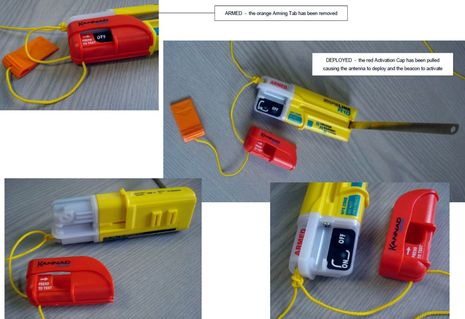
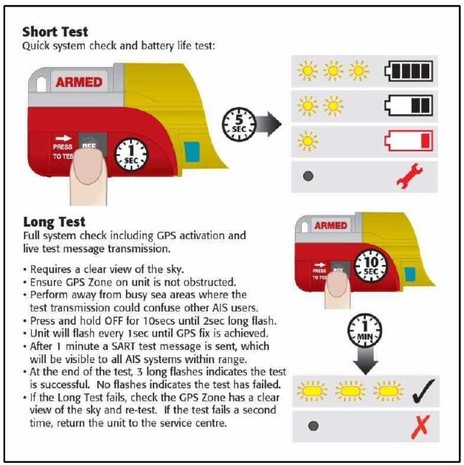
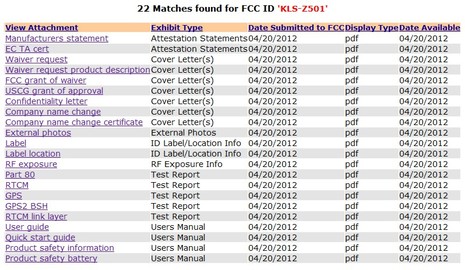
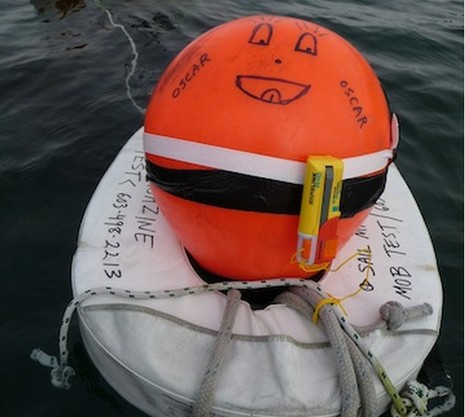
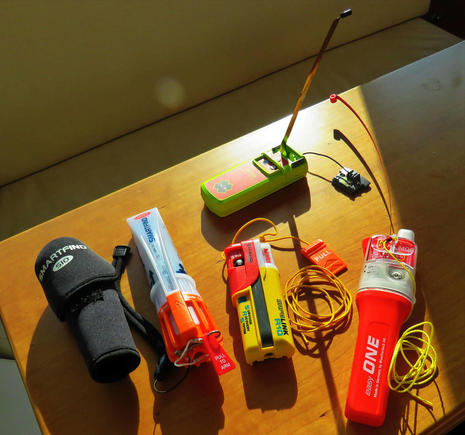
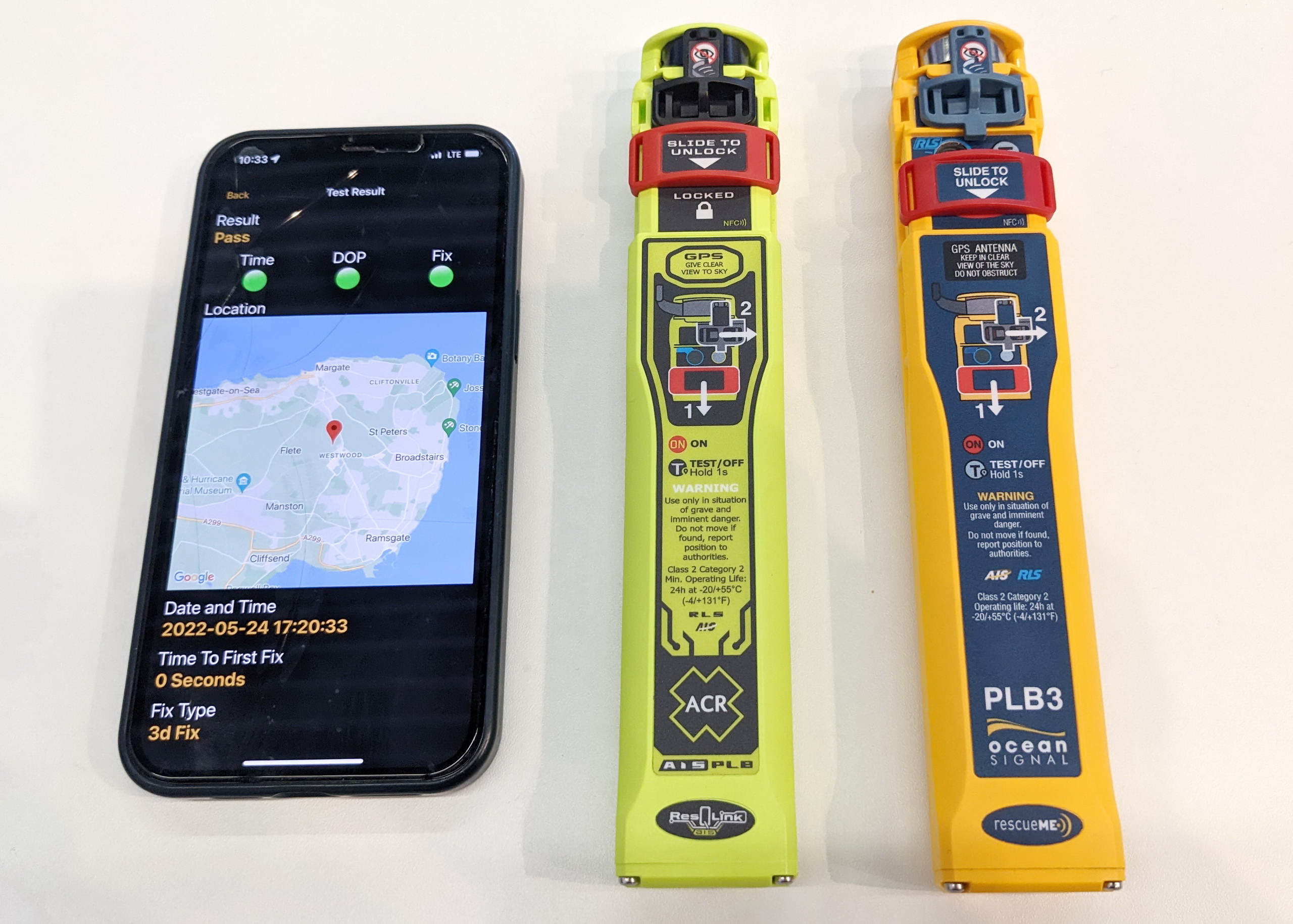








No surprise the McMurdo SafeLink S10 personal AIS beacon also made it through the FCC, as its internals are very similar to the R10’s. It’s designed more for commercial use and for divers (60 meter waterproof) rating, but it might appeal to some boaters: http://goo.gl/0jQgz
Ben,
We bought the S10 from Cactus in England. Shipping, duty et al brought it up to $355 but the duty and customs part was all invisible to us: we just gave them a CC number and the thing arrived a week or so later.
While this unit can be tested to see if and how it will work, do you know what the procedure will be for replacing the batts when they no longer test good? The packaging says they are lithium-magnesium: probably not something that Radio Shack stocks and suspect that opening the case is not suggested.
We have not tried ours but look forward to a bit more warm weather so that we can roll the boat out of her shed and fire up our class B AIS and see how the S 10 will work with it. (Do you know if these devices will work differently with the various classes of AIS receivers and transponders?)
Garry
Gary, Like most all EPIRBs and PLBs, the battery in AIS SARTs must be factory serviced. But it’s a powerful battery with long (and highly tested) life.
All AIS receivers and transponders will receive AIS SART messages because they use data fields established at the very beginning of AIS. The question is what your AIS plotting system does with the message. Because all AIS SARTs are unique in using an MMSI # starting with “970” and also in putting out either “SART TEST” or “SART ACTIVE” text, it’s quite possible for an AIS device to treat them in a special way. Here’s an example of how well a Test message can be handled: http://goo.gl/kGZCY
The worse case is that whatever you use to plot AIS targets will see the SART as a regular ship target. However, it will be one that suddenly appears just aft of your position, which may well fire off a CPA alarm.
Ben,
Am not a geek and became pretty well lost when I went to the goo URL in your message above. However, did catch that you are not sure how well the Simrad Class B AI50 will work with AIS SARTs and MOBs. Since that his what we have aboard Rising Wind, and like it a lot, am now even more curious to see how it will work with the S10.
Garry
Sorry about that, Gary; that is a particularly geeky entry!
I tested the orginal Simrad AI50 and liked it quite a bit. But I just looked over the latest manual and don’t see any mention of a special SART alarm like I saw on the somewhat similar Vesper Marine WatchMate ( http://goo.gl/DplN7 ) though it’s possible it’s just not in the manual.
At any rate, I’m confidant that you’ll see your AIS personal SART on the AI50 and will be able to get it to generate an alarm on AI50 based on CPA, but you may also get that alarm when you pass close to an AIS-equipped vessel, even if it’s tied up.
Hi Ben,
Any word on how long the GPS takes to acquire a position?
If I’m reading the test document submitted to the FCC properly, the uBlox NEO GPS receiver used in the R10 can acquire position from a cold start in about 30 seconds. And that’s an average of over 500 test measurements, 100% of which delivered a position error less than 14 meters. Also tested were valid position after long and short periods of no GPS signal (a big wave breaking over you) or no power, and re-acquisition was even quicker.
But let’s note that this testing, though designed for the conditions these devices are used in, are actually simulations. But, then again, I’ve seen cold starts this quick with the easyrescue AIS SART I tested as well as various PLBs, all in real if not usually wet conditions. GPS tech has gotten very good.
I guess I’m just confused…do these AIS SART/MoB devices also have PLB functions as well? Or, will they only supplement those?
If I’m not just confused, shouldn’t we have a single device which merges the two technologies into a single package? I’m getting the impression that the SART/MoB devices are VHF only, with zero sat capability…
Seems like the AIS function should be a mandatory inclusion into a PLB…or, at least an optional one.
It is confusing, Karl, but mainly because several different technologies are evolving to the point where they can help with MoB situations. The current value of personal AIS SARTs is for local rescue, either by the boat you fell off or one that’s nearby. But there’s already an AIS monitoring company which has demonstrated that it can see even AIS SARTs from space and says it could do so worldwide if given sufficient funding for its nano satellite network: http://goo.gl/bVBKE
In the meantime, AIS is definitely being considered for 406 MHz EPIRBs and PLBs as a replacement for the secondary 121.5 MHz local homing signal. Then a PLB could do what these personal SARTs do and also notify the international SAR community of your problem. But, as we saw with the AIS SARTs, it takes years to create the standards, then develop the devices, and finally to get the devices tested and approved to the standard. (I believe in the process though!)
And then there’s DSC technology, which already has the ability to loudly alarm the watch stander of almost any nearby vessel with the location of an MoB. A rational way to put that functionality into a personal device is also being explored, as we discussed here: http://goo.gl/nvyN3
It is confusing and whatever you do there may be a better choice in a year or two. But then again I sure wouldn’t want to be the guy in the water watching his boat cruising away and saying to himself, “Damn, maybe I shouldn’t have waited for the next generation.” Just saying 😉
I had the opportunity to play with two of them at a safety seminar in NYC last month. I found the arming tab to be ridiculously difficult to remove.
Is it that way normally, or could it be those units were handled too much?
Please go to the NY Tugmaster’s Weblog to read about the mariner lost on April 25th. No PFD and no AIS MoB beacon. -Doug
http://captbbrucato.wordpress.com/2012/04/29/no-comfort/
More on Capt. O’Leary here:
http://www.thebostonchannel.com/news/30959457/detail.html
Seems like there has been an ugly rash of boating fatalities in the last couple of weeks.
Here’s something I missed: The WeatherDock easyRescue personal AIS SART actually won FCC approval before the Kannad/McMurdo products did, on March 16. I don’t see a U.S. dealer on their site yet, but I imagine that’s coming. Also, there are now more versions of SART, including on that’s automatic “by means of full water contact”: http://goo.gl/DCsf8
Weatherdock is a small outfit but very responsive. Their products under the “easy” name have been very common in Germany for a number of years. Before the easyResuce, they have never made a waterproof product but I have not heard about problems.
I see this conundrum with any kind of MOB beacon using VHF frequencies: If it is to be seen for at least a half mile, the antenna needs to be of a minimum length and it needs to be held upright and well above water level. On the other hand, more and more potential buyers seem to demand auto-activation on water contact.
This is a conflict if the water sensor is included in the body of the unit as does the the easyRESCUE-A A049. It also has a stubby antenna too short, really, for VHF frequencies. It says that it floats but the stubby antenna is pointing downward into the water if it does, negating it’s purpose.
I really think the manufacturers need to do better and they must do so by tight and perfect integration with life vests to achieve:
1. deployment and activation by the life vest mechanism not an internal water sensor or else a water sensor external to the unit and dangling into the water by a wire (I have read recent reports about life vest lights turning off prematurely when the light is lifted from the water by the vest being deployed)
2. fixed, firm and secure antenna position at the highest point of the life vest pointing straight up
3. antenna length of about a foot (as has the non-automatic easyRescue)
Each model should come with a list of supported life vests.
The force needed to deploy the beacon and unfold the antenna should come from the life vest bladder being inflated.
Buyers should be aware that with the current models you can’t just pay up and be rid of your safety concerns. And an automatic beacon does not go without a life jacket. You must be prepared to bin your existing life vest and get a new one designed for the model of beacon you chose.
And if you aren’t in the habit of wearing a life jacket, don’t waste your money on an automatic model.
The use of AIS for MOB and survival craft adds an important tool to save lives. Add to this the 406 EPIRB, a VHF DSC radio connected to the GPS, and the knowledge on how best to use the equipment and you have greatly increased your chances of survival in the event of a distress. Adding an AIS to help you “see and be seen” is a cheap investment in safety. I am always amazed how many people depend strictly on their cell phone and do not carry a VHF radio of any kind. The Coast Guard has tried to educate the public and they can do wonders in the event of a distress but first they have to find you. Finding you is the short fall of the cellphone. There is an old saying that “Safety is not sexy and does not sell”.
Landfall Navigation came out online today with a nice feature on this unit, which they are selling of course. It includes a short video. You can check it out at http://www.landfallnavigation.com/kannadsafelink.html
Ben have to agree with Dan. I went to Landfall to purchase one and found it much to hard for Sally and I to get the cover off to set it off. Even while standing in the store let alone while thrashing around in the water. Great idea but execution lacking. Didn’t buy it.
Still do not have a man overboard alarm!
Allan Seymour
Bug Alert: Garmin MFDs with certain firmware can apparently shut down upon receipt of an AIS Sart test message. Here’s the note that went out to all the skippers prepping for the Bermuda Race:
“It has recently come to Garmin’s attention that test signals from Kannad SafeLink R10 Survivor Recovery Systems may inadvertently cause Garmin GPSMAP chartplotters with the software versions stated below to shut down unexpectedly. Garmin has updated its chartplotter operating system software to prevent this from occurring. The software updates are easily downloaded from our web site at http://www8.garmin.com/support/software/marine.html and should be uploaded into your Garmin chartplotter by SD card. Please note that the following devices and software versions have been determined by Garmin to be affected:
o GPSMAP 4008/4010/4012/4208/4210/4212: Software version 7.30
o GPSMAP 5008/5208/5012/5212/5015/5215: Software version 7.30
o GPSMAP 6008/6208/6012/6212: Software version 4.30
o GPSMAP 7012/7212/7015/7215: Software version 4.30
o GPSMAP 720/740/750: Software version 3.80″
Garmin also sent two techs to Newport with 50 SD cards, which is pretty fine customer service!
I don’t know if this bug happens regardless of whether the AIS messages are coming in via NMEA 0183 or 2000, but I suspect that if it’s happening with the Kannad R10, it’s happening with any AIS Sart, as the messages are standard.
Allan and Dan, I asked Charlie Doane if he too had found the R10 difficult to use and he did not. More on his testing and the Garmin glitch here: http://goo.gl/V2iCb
Bug Alert 2: Garmin amended the warning above…
TO: NEWPORT BERMUDA RACE CAPTAINS
Garmin advises that the software versions listed in Tuesday’s e-mail that are described as being affected by the Kannad SafeLink R10 test signals are actually the updated versions that need to be installed to avoid the problem. The affected software that is in urgent need of updating is:
GPSMAP 4008/4010/4012/4208/4210/4212: Software version 7.20
GPSMAP 5008/5208/5012/5212/5015/5215: Software version 7.20
GPSMAP 6008/6208/6012/6212: Software version 4.20
GPSMAP 7012/7212/7015/7215: Software version 4.20
GPSMAP 720/740/750/720s/740s/750s: Software version 3.70
Sorry but yesterday I tested a Wamblee W420 in Garmin Italy with a chartplotter 4012 updated to 7.3 and still the switchoff problem during the AIS SART Test sequence.
We have send to Garmin Italy the NMEA AIS TEST sequence for debugging operation.
Just for your information, this is the TEST sequence in the W420 Wamblee :
ID unit = 972580000 (0000 is for our test purpouse)
!AIVDM,1,1,,A,>>OQT`0lt:1@E=@,2*55
!AIVDM,1,1,,B,1>OQT`?P?w4?wv1P00,0*56
!AIVDM,1,1,,A,1>OQT`?P?w4?wv1P00,0*55
!AIVDM,1,1,,B,1>OQT`?P?w4?wv1P00,0*56
!AIVDM,1,1,,A,1>OQT`?P?w4?wv1P00,0*55
!AIVDM,1,1,,B,1>OQT`?P?w4?wv1P00,0*56
!AIVDM,1,1,,A,1>OQT`?P?w4?wv1P00,0*55
!AIVDM,1,1,,B,>>OQT`0lt:1@E=@,2*56
If you know someone in Garmin USA (involved in ChartPlotter software) , I think these NMEA row can be usefull
Thanks, Daniele. I think Garmin does read Panbo, but I also forwarded your comments to the marine software division. They are definitely working on the problem, but note that it purportedly only involves Test Mode not a real MoB alert. Have you tried doing a real life test with the Wamblee?
Also, this discussion has gotten split over two entries, and I think it would be better to continue on the more recent one:
https://panbo.com/archives/2012/06/ais_mob_devices_were_in_the_learning_phase.html
Hello,
Does any one test the pub ais with simrad ai50 ?
What are the results ?
Regards